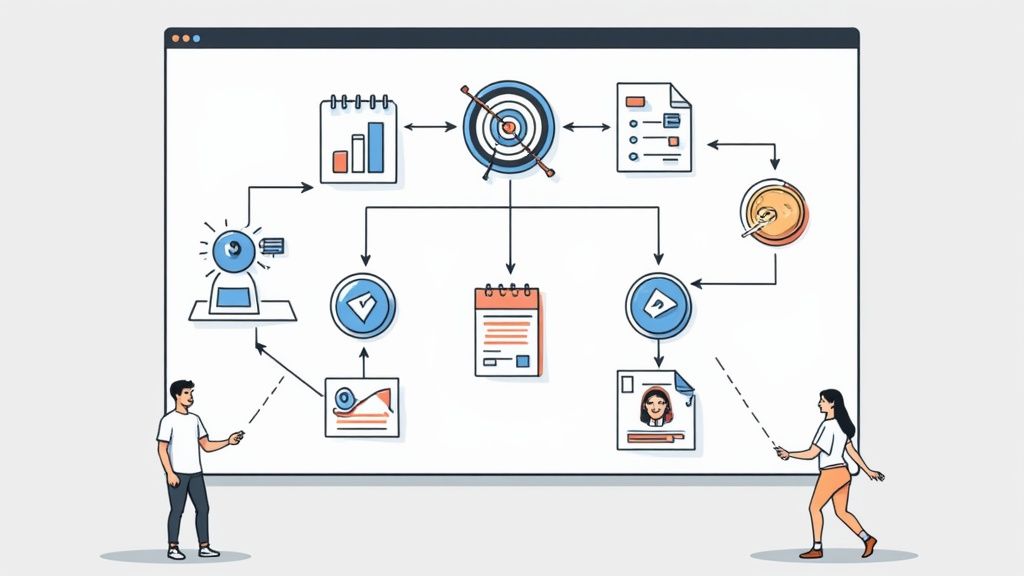
Influencer Marketing Manager Job Description: 7 Key Tips
Published
Decoding the Influencer Marketing Manager Role
This listicle outlines the core responsibilities of an Influencer Marketing Manager. Whether you're a seasoned professional, a job seeker, or involved in hiring, understanding these key functions is crucial for success. From strategy and influencer selection to campaign execution, reporting, and budget management, we cover the essential skills and tasks. This breakdown provides valuable insights for navigating this exciting and evolving field. Learn what it takes to excel and gain a competitive edge.
1. Influencer Campaign Strategy Development
Influencer campaign strategy development is the cornerstone of successful influencer marketing. It's the process of crafting a comprehensive plan that leverages influencer partnerships to achieve specific brand objectives. This involves a detailed approach encompassing everything from defining campaign goals and identifying the target audience to establishing key performance indicators (KPIs), allocating budgets, creating content guidelines, and setting campaign timelines. The ultimate aim is to maximize return on investment (ROI) and boost brand awareness through strategic influencer collaborations. This crucial first step ensures that influencer marketing efforts are not haphazard but rather data-driven and aligned with overarching business goals.

This strategic approach includes features like:
- Goal setting and alignment with broader marketing objectives: Ensuring the influencer campaign contributes to the overall marketing strategy.
- Budget planning and resource allocation: Defining how much will be spent and where those resources will be allocated.
- Campaign theme and narrative development: Creating a compelling story that resonates with the target audience.
- Platform selection based on audience demographics: Choosing the right social media platforms where the target audience is most active.
- Timeline creation with key milestones: Setting a clear schedule with measurable progress points.
The pros of a well-defined influencer campaign strategy are numerous:
- Ensures a structured approach to influencer marketing: Moves away from ad-hoc collaborations to a more strategic and measurable approach.
- Aligns influencer efforts with business goals: Ensures influencer activities directly contribute to achieving desired outcomes.
- Increases the likelihood of campaign success through careful planning: Minimizes risks and maximizes opportunities by anticipating potential challenges.
- Provides a clear framework for measuring results: Makes it easier to track progress and demonstrate the value of influencer marketing.
However, strategy development also has its challenges:
- Time-intensive process requiring significant planning: Developing a robust strategy requires dedicated time and effort.
- Strategies may need frequent adjustment as trends change: The dynamic nature of social media requires flexibility and adaptability.
- Forecasting accurate ROI can be challenging: Predicting the exact return on investment can be difficult due to various external factors.
Several brands have demonstrated the power of effective influencer campaign strategy:
- Gymshark's ambassador program: This program transformed fitness influencer marketing by building a loyal community of brand advocates.
- Dunkin' Donuts' partnership with Charli D'Amelio: This collaboration resulted in a 57% increase in app downloads, showcasing the impact of aligning with the right influencer.
- Daniel Wellington's #DWPickoftheDay campaign: This campaign effectively built the brand primarily through influencer marketing, demonstrating the potential for rapid growth.
To develop successful influencer campaigns, consider these tips:
- Always start with clearly defined and measurable objectives: Knowing what you want to achieve is crucial for effective planning.
- Create flexible strategies that can adapt to influencer feedback: Be open to incorporating influencer insights to optimize campaign performance.
- Develop contingency plans for underperforming campaigns: Have backup plans in place to address potential setbacks.
- Benchmark against competitor strategies but find unique angles: Learn from others but differentiate your approach to stand out.
Influencer campaign strategy development deserves its place on this list because it is the foundational element upon which all other aspects of influencer marketing are built. Without a clear strategy, efforts can be fragmented, resources wasted, and results underwhelming. This approach, popularized by industry leaders like Glossier's Emily Weiss, HubSpot, and Fenty Beauty, has proven its effectiveness in building brands and achieving significant business growth. Learn more about Influencer Campaign Strategy Development This structured approach is essential for anyone involved in influencer marketing, from individual professionals to agencies, ensuring campaigns are aligned, impactful, and deliver measurable results.
2. Influencer Identification and Selection
A cornerstone of any successful influencer marketing campaign is the careful selection of the right influencers. This stage, Influencer Identification and Selection, involves researching, identifying, and vetting potential influencers who not only align with your brand values but also possess the ability to effectively reach and resonate with your target audience. This process goes far beyond simply choosing someone with a large following; it requires a deep dive into metrics like engagement rates, audience demographics, content quality, and authenticity. Ultimately, the goal is to select influencers who will deliver the best return on investment (ROI) and represent your brand in a positive and impactful way.

This crucial responsibility involves several key features: analyzing audience demographics to ensure alignment with your target market; assessing engagement rates to gauge audience responsiveness; evaluating content quality to ensure it meets brand standards; verifying brand alignment to maintain a consistent brand image; assessing authenticity and credibility to ensure genuine influencer-audience relationships; and reviewing past campaign performance to predict future success. Learn more about Influencer Identification and Selection for a deeper understanding of best practices.
Finding the right influencer marketing manager is crucial for success. A strong candidate will possess a blend of marketing acumen, social media expertise, and excellent communication skills. For a deeper dive into the hiring process, how to hire a social media manager provides expert tips from Your Social Strategy.
This meticulous approach yields several significant advantages. By partnering with influencers who genuinely resonate with the target audience, brands can foster stronger connections and build trust. Strategic influencer selection minimizes the risk of brand safety issues, ensuring that brand messaging remains consistent and avoids potentially damaging associations. Furthermore, careful matching maximizes campaign effectiveness, leading to higher engagement and conversion rates. Finally, this process facilitates the development of long-term, valuable relationships with creators who understand and support the brand's vision.
However, Influencer Identification and Selection is not without its challenges. The research and vetting process can be time-consuming, requiring thorough analysis and due diligence. Influencer data, such as follower counts and engagement rates, can sometimes be inflated or misrepresented, necessitating careful verification. Competition for top-tier influencers can drive up costs, making budget management a crucial consideration. And finally, predicting actual influencer performance can still be challenging, despite thorough analysis.
Successful examples of Influencer Identification and Selection abound. Sephora's #SephoraSquad program meticulously selects micro-influencers based on engagement and authenticity, fostering a strong community around the brand. Adobe's selection process for their Creative Residency program focuses on identifying artists who embody creativity and innovation. American Express's careful vetting for their ambassador program prioritizes alignment with their core business values.
To streamline the Influencer Identification and Selection process, consider these practical tips: Utilize a combination of influencer platforms and manual research to gain a comprehensive overview of potential partners. Develop a standardized scoring system for evaluating influencers based on key metrics. Request engagement statistics directly from influencers to ensure accuracy. Conduct background checks to identify any potential past controversies. And finally, start with small trial campaigns before making major investments to test influencer performance and refine your strategy. Agencies like Obviously, with their methodical approach to influencer selection, MediaKix, and their comprehensive vetting framework, and Traackr, a pioneer in developing influencer selection technology, have popularized these best practices.
3. Relationship Management and Communication
As an influencer marketing manager, a significant portion of your role revolves around building and nurturing relationships with influencers. This involves acting as the central point of contact between your brand and the content creators you collaborate with. It's a multifaceted process that encompasses everything from initial outreach and contract negotiations to ongoing communication, feedback delivery, and fostering long-term partnerships. Effective relationship management ensures campaigns run smoothly, content aligns with brand objectives, and influencers feel valued and understood. This approach prioritizes building genuine connections with influencers, recognizing them as valuable partners rather than just transactional entities. Doing so transforms influencer marketing from a series of one-off campaigns into a sustainable strategy that delivers long-term value.

This aspect of influencer marketing management is crucial because it directly impacts the authenticity and effectiveness of your campaigns. Influencers who feel valued and understood are more likely to create genuine content that resonates with their audience. Features of successful relationship management include establishing clear contract terms, maintaining a regular communication cadence, providing comprehensive briefs and creative direction, implementing feedback mechanisms and performance reviews, establishing conflict resolution protocols, and actively nurturing long-term relationships. This holistic approach ensures both the brand and the influencer benefit from the partnership.
Examples of successful implementation: Revolve's #RevolveFestival exemplifies the power of ongoing influencer relationships, maintaining connections with hundreds of influencers year-round. Benefit Cosmetics' Brow Bar influencer program and GoPro's Creator program similarly prioritize long-term partnerships and dedicated relationship management. These examples highlight how consistent engagement can yield significant returns.
Pros: Building trust and loyalty with influencer partners increases the likelihood of authentic content creation, enables more efficient campaign execution, can lead to better rates and exclusivity opportunities, and creates brand advocates beyond paid partnerships.
Cons: Relationship management is time-intensive and requires excellent interpersonal and negotiation skills. Managing multiple relationships simultaneously can be challenging, and finding the balance between brand needs and influencer creative freedom requires careful consideration.
Tips for effective relationship management:
- Implement a CRM system specifically for influencer relationship management.
- Schedule regular check-ins beyond campaign periods.
- Send personalized gifts and recognize milestones.
- Create an influencer community or private group for your brand partners.
- Develop clear communication templates and guidelines.
- Remember personal details and preferences for each influencer.
Learn more about Relationship Management and Communication to delve deeper into these strategies. This aspect deserves its place on this list because strong relationships are the foundation of successful influencer marketing. The benefits – authentic content, efficient campaigns, and long-term brand advocacy – far outweigh the challenges. Pioneering approaches by companies like Tribe Dynamics, Fohr, and Whalar highlight the importance of prioritizing relationships in this dynamic field. By adopting these strategies, you can unlock the full potential of influencer marketing and achieve meaningful results.
4. Content Strategy and Creative Direction
A core function of an Influencer Marketing Manager is developing robust content strategies and providing clear creative direction for influencer campaigns. This involves meticulously crafting campaigns that resonate with the brand's messaging while simultaneously leveraging the influencer's unique voice and style. It's a delicate balancing act: maintaining brand consistency across multiple influencers while allowing enough creative freedom for authentic and engaging content. This means creating detailed briefs, outlining content calendars, establishing messaging guidelines, and providing visual direction that bridges the gap between brand requirements and influencer authenticity.

This aspect of influencer marketing management is crucial because it ensures cohesive brand storytelling across various platforms and influencer personalities. Key features include campaign brief development, content calendar creation, establishing brand voice and messaging guidelines, providing visual identity direction, optimizing content for specific platforms, and developing a comprehensive storytelling framework. By strategically planning content, managers can maximize its effectiveness and create more integrated campaigns across all marketing channels. Think of it as conducting an orchestra: each influencer plays their own instrument (their unique content style), but the Influencer Marketing Manager is the conductor, ensuring they all harmonize to create a beautiful symphony (a cohesive brand message).
Examples of Successful Implementation:
- Glossier: Known for giving influencers significant creative freedom within clearly defined brand guidelines, resulting in authentic and diverse content.
- Away: Focuses on travel storytelling through influencers, leveraging their personal experiences to connect with their target audience.
- Old Navy's #BodyEquality campaign: Provided inclusive creative direction across a diverse range of influencers, promoting body positivity and inclusivity.
Pros:
- Ensures cohesive brand messaging across multiple influencers.
- Maximizes content effectiveness through strategic planning.
- Balances brand control with influencer creativity.
- Creates more integrated campaigns across marketing channels.
Cons:
- Overly rigid direction can stifle influencer authenticity.
- Requires a blend of creative and analytical skills.
- Content trends evolve rapidly, demanding constant adaptation.
- Managing creative expectations between brand teams and influencers can be challenging.
Actionable Tips:
- Visual Mood Boards: Create visual mood boards to effectively communicate the desired brand aesthetic and inspire influencer creativity.
- Flexible Templates: Develop templates for briefs and content calendars that provide structure while allowing for creative flexibility.
- Creative Workshops: Conduct creative workshops with influencers before launching campaigns to foster collaboration and ensure alignment.
- Content Testing: Test content concepts with smaller influencer groups before full deployment to gauge audience response and optimize performance.
- Influencer Input: Incorporate influencer input during the creative development process to leverage their expertise and ensure authenticity.
- Do's and Don'ts: Create "do's and don'ts" guides rather than strict scripts to provide clear boundaries while encouraging creative expression.
When and Why to Use This Approach:
Content strategy and creative direction are essential for every influencer marketing campaign. This approach is particularly important when:
- Launching a new product or service.
- Running a large-scale campaign with multiple influencers.
- Trying to build brand awareness and establish a consistent brand identity.
- Targeting a new audience segment.
Inspiration and Further Learning:
- Later Media: Known for its strategic approach to visual content planning.
- Collectively Inc: Employs a creator-first content development methodology.
- Sprout Social: Offers integrated content strategy frameworks.
This element deserves its place on this list because it forms the backbone of successful influencer marketing. Without a well-defined content strategy and clear creative direction, campaigns risk becoming disjointed and ineffective. By mastering this skill, Influencer Marketing Managers can ensure that influencer collaborations genuinely enhance brand messaging and resonate with target audiences.
5. Campaign Execution and Monitoring
Campaign execution and monitoring is the operational heart of influencer marketing. It's the process of overseeing every aspect of a campaign's lifecycle from the moment it launches to its conclusion, ensuring seamless implementation, adherence to best practices, and optimal performance. This stage involves a delicate balance of meticulous planning, proactive management, and reactive problem-solving. This crucial step ensures that meticulously crafted strategies translate into tangible results. Without robust execution and monitoring, even the most brilliant campaign concept can fall flat.
How it Works:
Campaign execution and monitoring involves a multi-faceted approach:
- Content Review and Approval: Before any content goes live, it needs to be reviewed and approved to ensure it aligns with the brand's messaging, campaign objectives, and disclosure guidelines. This process involves establishing clear workflows and accountability for all parties involved.
- Publication Schedule Management: Maintaining a precise publication schedule across multiple influencers and platforms is essential for synchronized impact. This requires detailed planning and coordination, often involving specialized scheduling tools.
- Real-Time Campaign Monitoring: This involves actively tracking campaign performance metrics, such as engagement, reach, and conversions, as they happen. This allows for immediate identification of potential issues or opportunities for optimization.
- FTC Compliance Verification: Ensuring all influencer content complies with FTC guidelines regarding sponsored content disclosure is paramount. This requires diligent monitoring and enforcement to avoid legal ramifications.
- Performance Tracking Dashboard Maintenance: Utilizing dashboards to visualize key performance indicators (KPIs) provides a comprehensive overview of campaign progress and allows for data-driven decision-making.
- Crisis Management Protocols: Having a pre-established plan for addressing unexpected issues, such as negative comments or influencer controversies, is critical for mitigating potential damage to the brand's reputation.
Examples of Successful Implementation:
- e.l.f. Cosmetics' TikTok #EyesLipsFace Campaign: This viral campaign required real-time monitoring and adaptation to capitalize on trending content and user-generated contributions. The brand actively engaged with the community and adjusted the campaign based on real-time feedback.
- ASOS' Influencer Campaigns with Coordinated Global Product Launches: ASOS leverages influencers for synchronized product launches across various regions, demonstrating the power of coordinated execution for maximizing impact.
- Chipotle's #GuacDance Campaign: This campaign's success hinged on synchronized execution across multiple platforms, requiring meticulous coordination between influencers and the brand.
Actionable Tips:
- Implement project management software: Tools like Asana or Trello can streamline workflows and facilitate collaboration.
- Create standardized approval workflows: Establish clear guidelines and accountability for content review and approval.
- Develop a communication protocol for urgent campaign issues: Ensure all stakeholders know how to communicate effectively in case of emergencies.
- Conduct pre-campaign technical checks with all influencers: This helps avoid technical difficulties during campaign execution.
- Build buffer time into all campaign timelines: This allows for flexibility and minimizes the impact of unexpected delays.
- Use automated monitoring tools: Platforms like Dash Hudson, Tribe Dynamics, and Tagger Media provide real-time campaign surveillance and valuable insights.
Why This Item Deserves Its Place in the List:
Campaign execution and monitoring is the bridge between strategy and results. Without diligent oversight and proactive management, even the most well-planned campaigns can fail to achieve their objectives. This stage is critical for ensuring smooth operation, maximizing ROI, and maintaining brand reputation.
Pros and Cons:
Pros:
- Ensures campaigns run smoothly and on schedule.
- Allows for real-time optimization and course correction.
- Maintains regulatory compliance to avoid legal issues.
- Provides immediate insights into campaign effectiveness.
Cons:
- Requires constant attention and availability.
- Technical issues across platforms may require troubleshooting.
- Managing multiple simultaneous campaigns can be logistically complex.
- Unexpected social media algorithm changes can impact planned execution.
This meticulous approach, popularized by tools like Dash Hudson's real-time monitoring, Tribe Dynamics' sophisticated campaign tracking, and Tagger Media's end-to-end campaign management system, is vital for any successful influencer marketing manager. It ensures not just the smooth execution of campaigns but also provides the agility to adapt and optimize in the dynamic landscape of social media.
6. Performance Analysis and Reporting
Performance analysis and reporting is the backbone of successful influencer marketing. It involves systematically measuring, analyzing, and reporting on the outcomes of your influencer campaigns against pre-defined Key Performance Indicators (KPIs). This process provides crucial data-driven insights that inform strategic decisions, optimize future campaigns, and demonstrate the value of your influencer marketing investments. This is a critical component of an Influencer Marketing Manager’s job description because it directly ties the activities to tangible business results. Without robust performance analysis, it's impossible to determine whether your influencer program is achieving its objectives and contributing to the overall marketing strategy.
How it Works:
The process begins with establishing clear KPIs aligned with your campaign goals. These could include reach, engagement (likes, comments, shares), website traffic, conversions (sales, sign-ups), brand lift (awareness, sentiment), and ultimately, return on investment (ROI). Data is then collected from various sources, including social media platforms, influencer marketing platforms, and website analytics. This data is analyzed to identify trends, high-performing influencers and content, and areas for improvement. Finally, the insights are compiled into comprehensive reports for stakeholders, often visualized through dashboards and presentations.
Features:
- KPI tracking and measurement: Utilizing tools and techniques to monitor progress against established KPIs.
- Data collection across multiple platforms: Gathering data from various social media platforms, influencer platforms, and internal analytics systems.
- Campaign ROI calculation: Determining the financial return generated by influencer marketing activities.
- Competitive benchmarking: Analyzing competitor influencer strategies and performance.
- A/B testing analysis: Comparing the effectiveness of different campaign elements (e.g., creative, targeting).
- Attribution modeling: Identifying which touchpoints in the customer journey are influenced by influencer marketing.
- Custom dashboard creation: Developing visual representations of key performance data for easy interpretation.
Pros:
- Demonstrates the value of influencer marketing investments to stakeholders.
- Identifies high-performing influencers and content types for future collaborations.
- Provides data-driven insights for future campaign optimization and strategy refinement.
- Justifies budget allocation and potential expansion of influencer marketing efforts.
Cons:
- Attribution challenges: Difficulties in accurately attributing conversions in multi-channel marketing environments.
- Data collection limitations: Inconsistencies and limitations in data availability across different social media platforms.
- Time lag: Delays between campaign execution and the availability of measurable results.
- Complex ROI calculations: Challenges in capturing the full brand impact and long-term value of influencer marketing beyond immediate conversions.
Examples of Successful Implementation:
- HelloFresh: Uses a comprehensive attribution model to track influencer-driven conversions and measure the impact on customer acquisition cost.
- Sephora: Analyzes the impact of its Beauty Insider community, including influencer collaborations, on brand engagement and sales.
- Airbnb: Conducts detailed analyses of influencer-driven booking patterns and travel trends to inform marketing strategies.
Actionable Tips:
- Establish clear baseline metrics before campaign launch to track progress effectively.
- Use unique tracking links/codes for each influencer to accurately attribute website traffic and conversions.
- Implement both quantitative (e.g., reach, engagement) and qualitative (e.g., sentiment analysis, brand lift) measurement approaches.
- Create standardized reporting templates for consistency and efficient communication with stakeholders.
- Compare performance across different influencer tiers (mega, macro, micro, nano) to identify the most effective partnerships.
- Incorporate sentiment analysis alongside engagement metrics to understand the emotional impact of influencer content.
- Schedule regular performance review meetings with stakeholders to discuss results, insights, and future strategies.
Popularized By:
- Launchmetrics' MIV (Media Impact Value): A methodology for quantifying the impact of media mentions and influencer content.
- Google Analytics' attribution modeling: Tools and techniques for analyzing influencer traffic and its contribution to conversions.
- Obviously agency's comprehensive ROI calculation framework: Methodologies for calculating the return on investment of influencer marketing campaigns.
By incorporating robust performance analysis and reporting into your influencer marketing strategy, you can demonstrate the value of your efforts, optimize campaign performance, and drive meaningful business results. This is an essential skill for any influencer marketing manager and a key area of focus for anyone seeking to excel in this field.
7. Budget Management and Contract Negotiation
Budget management and contract negotiation are crucial aspects of an influencer marketing manager's role. This involves allocating and optimizing budgets, negotiating fair compensation with influencers, managing payment processes, and ensuring all contractual agreements are adhered to. It's the backbone of successful influencer marketing campaigns, ensuring fiscal responsibility while maximizing ROI and fostering positive relationships with influencers. This facet of the job deserves its place on this list because it directly impacts campaign success and the overall health of the influencer marketing program.
How it Works:
The process begins with careful budget planning and allocation, taking into account campaign goals, target audience, and influencer selection. The influencer marketing manager then researches industry benchmarks and negotiates rates with influencers, developing compensation structures that align with the campaign's objectives. This includes crafting contracts that outline deliverables, timelines, usage rights, and payment terms. The manager also oversees payment processing, ensures compliance with all legal agreements, and tracks campaign performance to adjust budgeting strategies for future campaigns. Features of this process include:
- Budget planning and allocation: Determining the overall budget and allocating funds across different campaigns and influencers.
- Influencer rate negotiation: Discussing and agreeing upon fair compensation with influencers, considering their audience size, engagement rate, and the scope of the campaign.
- Contract development and review: Creating legally sound contracts that protect both the brand and the influencer, outlining all terms and conditions.
- Payment processing oversight: Managing and tracking influencer payments, ensuring timely and accurate compensation.
- Licensing and usage rights management: Defining how the influencer's content can be used and for how long.
- Exclusivity clause development: Negotiating exclusivity agreements with influencers, if required by the campaign.
- Performance-based compensation structuring: Linking influencer payments to specific campaign performance metrics, such as engagement or conversions.
Examples of Successful Implementation:
- Estée Lauder: Utilizes structured compensation tiers based on influencer categories (e.g., mega-influencers, macro-influencers, micro-influencers), providing a framework for consistent and fair compensation.
- Shopify: Employs a performance-based payment model for affiliate influencers, rewarding them based on the sales generated through their unique referral links.
- Nike: Develops long-term contract structures with exclusivity clauses, solidifying strong relationships with key influencers and securing their commitment to the brand.
Pros:
- Ensures fiscal responsibility and maximizes campaign ROI: Careful budget management helps control costs and ensures that marketing spend is used effectively.
- Creates clear expectations and legal protection for both parties: Contracts protect both the brand and the influencer, minimizing misunderstandings and potential disputes.
- Enables fair compensation that attracts quality influencers: Offering competitive rates and transparent payment processes attracts top talent.
- Provides structure for long-term partnership development: Well-managed contracts and positive payment experiences pave the way for ongoing collaborations with influencers.
Cons:
- Increasing influencer rates make budgeting challenging: The rising cost of influencer marketing can strain budgets, requiring careful planning and negotiation.
- Difficult negotiations can strain relationships: Negotiating rates and contract terms can sometimes lead to friction between brands and influencers.
- Legal complexities around intellectual property and usage rights: Navigating the complexities of intellectual property and usage rights can be challenging.
- Payment processing across international borders creates complications: Working with international influencers can introduce complexities related to currency exchange and international payment regulations.
Actionable Tips:
- Develop standardized rate cards based on audience size and engagement: This provides a baseline for negotiations and ensures consistency in influencer compensation.
- Include performance bonuses to incentivize stronger results: Tying compensation to performance motivates influencers to deliver exceptional results.
- Clearly define deliverables, revision policies, and timelines in contracts: This minimizes ambiguity and ensures that both parties are on the same page.
- Consult legal experts for complex rights management issues: Seek professional advice to navigate legal complexities and protect the brand's intellectual property.
- Create multi-campaign deals for better rates and continuity: Negotiating long-term partnerships can often result in more favorable rates and build stronger relationships.
- Consider value-added compensation beyond monetary payment: Offer perks like exclusive product access, event invitations, or co-creation opportunities to enhance the influencer experience.
- Implement approval processes for budget exceptions: Establish clear procedures for handling budget overruns or unexpected expenses.
Popularized By:
- Outloud Group: Known for their transparent pricing approach to influencer compensation.
- Captiv8: Provides data-driven insights for developing accurate rate cards.
- The American Influencer Council: Works towards standardizing contracts and best practices within the influencer marketing industry.
When and Why to Use This Approach:
Budget management and contract negotiation are essential for every influencer marketing campaign. These practices ensure financial responsibility, protect both the brand and the influencer, and create a foundation for successful and mutually beneficial partnerships. Failing to properly manage budgets and contracts can lead to financial losses, legal disputes, and damaged relationships with influencers.
7-Point Influencer Marketing Manager Role Comparison
| Title | 🔄 Implementation Complexity | ⚡ Resource Requirements | 📊 Expected Outcomes | 💡 Ideal Use Cases | ⭐ Key Advantages |
|---|---|---|---|---|---|
| Influencer Campaign Strategy Development | High – extensive planning and alignment | High – needs budget, tools, and research | High ROI and structured campaign success | Structured campaigns with clear objectives | Provides a clear framework and measurable goals |
| Influencer Identification and Selection | Moderate – detailed research and vetting | Moderate – relies on data tools and manual analysis | Enhanced influencer matching and campaign fit | Campaigns requiring precise audience and authenticity focus | Reduces risk through thorough vetting |
| Relationship Management and Communication | Moderate – ongoing negotiation and contact | Moderate – relies on interpersonal engagement and CRM systems | Long-term loyalty and smooth campaign execution | Long-term partnerships and brand advocacy initiatives | Builds trust and nurtures strong influencer bonds |
| Content Strategy and Creative Direction | Moderate – creative yet strategic planning | Moderate-High – depends on creative teams and resources | Consistent brand messaging and integrated storytelling | Campaigns that balance brand control with influencer creativity | Balances brand demands with influencer authenticity |
| Campaign Execution and Monitoring | High – continuous oversight and adaptation | High – requires monitoring tools and agile teams | Real-time optimization and timely issue resolution | Live campaigns needing instant adjustments and coordination | Ensures smooth execution with immediate course corrections |
| Performance Analysis and Reporting | Moderate – structured data analysis and reporting | Moderate – utilizes analytics tools and dashboards | Data-driven insights and clear performance measurement | Campaigns that benefit from quantitative evaluation | Informs future strategy with measurable KPIs |
| Budget Management and Contract Negotiation | High – involves complex negotiations and legal reviews | High – demands financial, legal, and administrative support | Optimized ROI and transparent contractual frameworks | Large-scale campaigns with multi-party collaborations | Ensures fiscal responsibility and structured agreements |
Mastering the Art of Influencer Marketing Management
The world of influencer marketing is dynamic and constantly evolving. From developing targeted campaign strategies to meticulously analyzing performance metrics, the seven key responsibilities outlined in this article—campaign strategy development, influencer identification and selection, relationship management, content strategy and creative direction, campaign execution and monitoring, performance analysis and reporting, and budget and contract negotiation—provide a comprehensive overview of what it takes to excel as an Influencer Marketing Manager. Mastering these core competencies allows you to not only effectively navigate this exciting landscape but also drive impactful results for brands, build authentic connections with influencers, and ultimately shape the future of marketing. By understanding these elements, you are empowered to create campaigns that resonate, build communities, and deliver exceptional ROI. These skills are highly sought after in today's digital marketing world, making a strong understanding of these core functions essential for career advancement.
Ready to put these insights into action and explore the vast potential of influencer marketing? Discover your next career move with Influencer Marketing Jobs, your gateway to a diverse range of opportunities in this thriving field. Connect with top brands and agencies seeking skilled influencer marketing professionals and take your career to new heights.